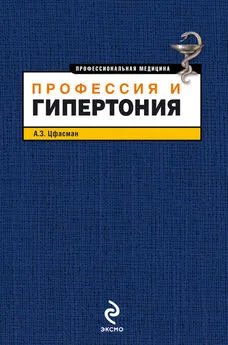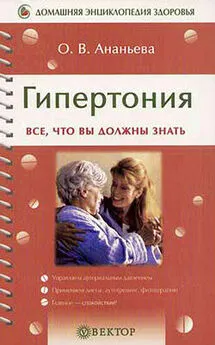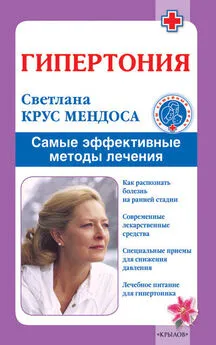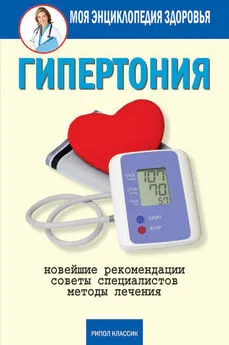Анатолий Цфасман - Профессия и гипертония
- Название:Профессия и гипертония
- Автор:
- Жанр:
- Издательство:неизвестно
- Год:неизвестен
- ISBN:нет данных
- Рейтинг:
- Избранное:Добавить в избранное
-
Отзывы:
-
Ваша оценка:
Анатолий Цфасман - Профессия и гипертония краткое содержание
Почему лечение нужно подбирать дифференцированно, с учетом профессиональных занятий пациента?
Эти и многие другие вопросы рассматриваются на стыке нескольких медицинских дисциплин в книге самых авторитетных специалистов по профессиональной медицине.
Врачи-кардиологи, терапевты, неврологи, профпатологи, доктора всех специальностей смогут использовать действительно современные подходы в лечении пациентов с артериальной гипертонией.
Профессия и гипертония - читать онлайн бесплатно полную версию (весь текст целиком)
Интервал:
Закладка:
Kitamura Т., Onishi K., Dohi K. et al. Circadian rhythm of blood pressure is transformed from a dipper to a non-dipper pattern in shift workers with hypertension. //J Hum Hypertens. – 2002. – vol. 16. – pp. 193–197.
Klein Т., Martens H., Dijk D.J. et al. Circadian sleep regulation in the absence of light perception: chronic non-24-hour circadian rhythm sleep disorder in a blind man with a regular 24-hour sleep-wake schedule. // Sleep. – 1993. – vol. 16. – pp. 333–343.
Klerman E.B., Shanahan T.L., Brotman D.J. et al. Photic resetting of the human circadian pacemaker in the absence of conscious vision. // J Biol Rhythms. – 2002. – vol. 17. – pp. 548–555.
Kripke D.F., Jean-Louis G., Elliot J.A. et al. Ethnicity, sleep, mood, and illumination in postmenopausal women. // BMC Psychiatry. – 2004. – vol. 4. – pp. 8–9.
Kurpesa М., Trzos E., Drozdz J. et al. Myocardial ischemia and autonomic activity in dippers and non-dippers with coronary artery disease: assessment of normotensive and hypertensive patients // Int J Cardiol. – 2002. – vol. 83(2). – pp. 133–142.
Lavie P., HererP., Hoff stein V. Obstructive sleep apnoea syndrome as a risk factor for hypertension: population study. // British Med J. – 2000. – vol. 320(7233). – pp. 479-82.
Leary A.C., Donnan P.T., MacDonald T.M. et al. Physical activity level is an independent predictor of the diurnal variation in blood pressure. // J Hypertens. – 2000. – vol. 18(4). – pp. 405–410.
Lewy A.J., Wehr T.A., Goodwin F.K. et al. Light suppresses melatonin secretion in humans. // Science. – 1980. – vol. 210. – pp. 1267–1269.
Light K.C., Brownley K.A., Turner J.R. et al. Job status and high-effort coping influence work blood pressure in women and blacks. // Hypertens. – 1995. – vol. 25 (4 pt 1). – pp. 554–559.
Lo S.H., Lin L.Y., Hwang J.S. et al. Working the night shift causes increased vascular stress and delayed recovery in young women. // Chronobiol Int. – 2010. – vol. 27(7). – pp. 1454–1468.
Lockley S. W., Skene D.J., Arent J. et al. Relationship between melatonin rhythms and visual loss in the blind. // J Clin Endocrinol Metab. – 1997. – vol. 82 – pp. 3763–3770.
Lowden A., Akerstedt Т., Wibom R. Suppression of sleepiness and melatonin by bright light exposure during breaks in night work. // J Sleep Res. – 2004. – vol. 13. – pp. 37–43.
Lozano-Lazaro M.G., Antequera-Noves R., Conejo-de la Cruz M.R. et al. Continuous care, one more cardiovascular risk factor to consider? // Enferm Clin. – 2010. – vol. 20(5). – pp. 292–296.
Lusardi P., Piazza E., Fogari R. Cardiovascular effects of melatonin in hypertensive patients well controlled by nifedipine: a 24-hour study. // Br J Clin Pharmacol. – 2000. – vol. 49. – pp. 423–427.
Mansoor GA. Sleep actigraphy in hypertensive patients with the “non-dipper” blood pressure profile. //J Hum Hypertens. – 2002. – vol. 16. – pp. 237–242.
Manuck S.B. Cardiovascular reactivity in cardiovascular disease // Int Behav Med. – 1999. – vol. 1. – pp. 4-31.
Meyer J.D. Occupational Health and the Heart. – 2003.
Micciolo R. Non-occupational lead exposure and hypertension in northern Italy. // Int J Epidemiol. – 1994. – vol. 23. – pp. 312–320.
Morrell M.J., Finn L., Kim H. et al. Sleep Fragmentation, Awake Blood Pressure, and Sleep – Disordered Breathing in a Population-based Study // Am J Respir Crit Care Med. – 2000. – vol. 162(6). – pp. 2091–2096.
Muller J.E., Stoone PH., Turi Z.G. et al. Circadian variation in the frequency of onset of acute myocardial infarction. // New England J Med. – 1985. – vol. 313(21).-pp. 1315–1322.
Munakata М., Abe K., Sasaki S. et al. Assessment of agedependent changes in circadian blood pressure rhythm in patients with essential hypertension. // J Hypertens. – 1991. – vol. 9(5). – pp. 790–798.
Netterstrem B., Kristensen T.S., Sjoi A. Psychological job demands increase the risk of ichaemic heart disease: a 14-year cohort study of employed Danish men. // Eur J Cardiovasc Prev Rehabil. – 2006. – vol. 13(3). – pp. 414–420.
Nomiyama K., Nomiyama H., Liu S. et al. Lead induced increase of blood pressure in female lead workers. // Occup Environ Med. – 2002. – vol. 59(11). – pp. 734–738.
O’Brien E., Murphy J., Tyndall A. et al. Twenty-four-hour ambulatory blood pressure in men and women aged 17 to 80 years: the Allied Irish Bank Study. // J Hypertens. – 1991. – vol. 9(4). – pp. 355–360.
O’Brien E., Sheridan J., O’Malley K. Dippers and non-dippers. // Lancet. – 1988. – vol. 2. – pp. 397.
O’Connor D.B., O’Connor R.C., White B.L. et al. Job strain and ambulatory blood pressure in British general practitioners: a preliminary study// Psychology, Health and Medicine. – 2000. – vol. 5(3).
Ohira Т., Tanigawa Т., Iso H. et al. Effects of shift work on 24-hour ambulatory blood pressure and its variability among Japanese workers. // Scand J Work Environ Health. – 2000. – vol. 26(5). – pp. 421–426.
Ohkubo Т., Hozawa A., Yamaguchi J. et al. Prognostic significance of the nocturnal decline in blood pressure in subjects with and without high 24-hour blood pressure: the Ohasama study. //J Hypertens. – 2002. – vol. 20 – pp. 2183–2189.
Ostry A.S., Kelly S., Demers PA. et al. A comparison between the effort-reward imbalance and demand control models // BMC Public Health. – 2003. – vol. 27. – pp. 3-10.
Otsuka К., Watanabe H., Comelissen G. et al. Gender, age and circadian blood pressure variation in apparently healthy rural vs metropolitan Japanese. // Chronobiologia. – 1990. – vol. 17(4). – pp. 253–265.
Paffenbarger R.S., WingA.L., Hyde R.T. et al. Physical activity and incidence of hypertension in college alumni. // Am J Epidemiol. – 1983. – vol. 117. – pp. 245–257.
Palatini P., Penzo М., Racioppa A. et al. Clinical Relevance of Nighttime Blood Pressure and of Daytime Blood Pressure Variability. // Arch. Int.Med. – 1992. – vol. 152(9).
Panda S., Nayak S.K., Campo B. et al. Illumination of the melanopsin signaling pathway. // Science. – 2005. – vol. 307 – pp. 600–604.
Parati G. Blood pressure reduction at night: sleep and beyond.// J Hypertens. – 2000. – vol. 18(12). – pp. 1725–1729.
Paulis L. Simko F. Blood Pressure Modulation and Cardiovascular Protection by Melatonin: Potential Mechanisms Behind. // Physiol Res. – 2007. – vol. 56. – pp. 671–684.
Pieters G.F., de Leeuw P. W., ArendJ.D. et al. Circulating adrenaline is not involved in the circadian blood pressure profile. //J Hypertens. – 1995. – vol. 13(12). – pp. 778–782.
Piko B. Epidemiology of cardiovascular disease (CVD). – 2005.
Pickering T.G. Psychosocial stress and blood pressure, in Hypertension Primer. – AHA. – 2000.
Pickering T.G. Mental stress as a casual factor in the development of hypertension and cardiovascular disease. // Current Hypertension Reports. – 2001. – vol. 3. – p. 249–254.
Portaluppi F., Cortelli P., Provini F. et al. Alterations of sleep and circadian blood pressure profile. // Blood Press Monit. – 1997. – vol. 2(6). – pp. 301–313.
Radi S., Lang Т., Lauwers-Cances V. et al. Job constraints and arterial hypertension: different effects in men and women: the IHPAF II case control study. // JOEM – 2005. – vol. 62. – pp. 711–717.
Rauchenzauner М., Ernst F., Hintringer F. et al. Arrhythmias and increased neuroendocrine stress response during physicians’ night shifts: a randomized crossover trial. // Eur Heart J. – 2009.
Rhodes W., Heslegrave R., Ujimoto K.V. et al. Impact of shift work and overtime on air traffic controllers – Phase II: Analysis of shift schedule effects on sleep, performance, physiology and social issues. // Final report TP12816E, Transportation Development Centre. Transport Canada. – 1996.
Reiter R.J., Tan D.-X., Korkmaz A. The circadian melatonin rhythm and its modulation: possible impact on hypertension. // J Hypertens. – 2009. – vol. 27 – pp. S17-S20.
Rio M.C. Strategy for the Implementation of a New Categorization System in Spain. // Guidelines for medical drugs (working group session). 16th International Conference on Alcohol, Drugs and Traffic Safety – Montreal: 2002 (ICADTS, T2002). – pp. 547–552.
Roach G.D., Reid K.J., Ferguson S. et al. The relationship between the rate of melatonin excretion and sleep consolidation for locomotive engineers in natural sleep settings. //J Circadian Rhythms. – 2006. – vol. 4. – p. 8.
Rosa R.R., Bonnet M.H., Bootzin R.R. et al. Intervention factors for promoting adjustment to nightwork and shiftwork. // Occup Med. – 1995. – vol. 5. – pp. 391–414.
Routledge F., McFetridge-Durdle J. Nondipping blood pressure patterns among individuals with essential hypertension: a review of the literature. // Eur J Cardiovasc Nurs. – 2007. – vol. 6(1). – pp. 9-26.
Riiger М., Gordijn М., Beersma D. et al. Weak relationships between suppression of melatonin and suppression of sleepiness/fatigue in response to light exposure. //J Sleep Res. – 2005. – vol. 14. – pp. 221–227.
Sandberg S., Kohvakka A., Cor din A. Rapid reversal of circadian blood pressure rhythm in shift workers. // J Hypertens. – 1988. – vol. 6(5). – pp. 425–429.
ScheerFA., Van Montfrans, Van Someren E.J. et al. Daily nighttime melatonin reduces blood pressure in male patients with essential hypertension. // Hypertens. – 2004. – vol. 43. – pp. 192–197.
Schnall P.L., Schwartz J.E., Landsbergis P.A. et al. Relation between job strain, alcohol, and ambulatory blood pressure // Hypertens. – 1992. – vol. 19(5). – pp. 488–494.
Schwartz G.L. Lead, blood pressure, and cardiovascular disease in men. // Arch Environ Health. – 1995. – vol. 50. – pp. 31–37.
Sekaran S., Lupi D., Jones S.L. et al. Melanopsin-dependent photoreception provides earliest light detection in the mammalian retina. // Curr Biol. – 2005. – vol. 15.-pp. 1099–1107.
Sharifian A., Farahani S., Pasalar P. et al. Shift work as an oxidative stressor. // J Circadian Rhythms. – 2005. – vol. 3. – p. 15.
Sherry P. Managing Fatigue in the Railroad Industry. // National Center for Intermodal Transportation University of Denver. – 2007.
Sicard B.A., Trocherie S., Moreau J., et al. Evaluation of zolpidem on alertness and psychomotor abilities among aviation ground personnel and pilots // Aviation, Space and Environmental Medicine. – 1993. – pp. 371–375.
Sjolin-Israelsson В.A., Enstrom I.E. The impact of work on the night blood pressure dipping profile. // Blood Press. – 2007. – vol. 16(1). – pp. 45–49.
Spenser C., Lip D. Hypertension. Epidemiology and risks. // Pharm J. – 1996. – vol. 263(7059). – pp. 280–283.
Staessen J.A., Bulpitt C.J., O\'Brien E. et al. The diurnal blood pressure profile. A population study. // Am J Hypertens. – 1992. – vol. 5(6 pt 1). – pp. 386-92.
Staessen J.A., O’Brien E.T. Development of diagnostic thresholds for automated measurements of blood pressures in adults. // Blood Pressure Monitoring. – 1999. – vol. 4. – pp. 127–136.
Читать дальшеИнтервал:
Закладка:








